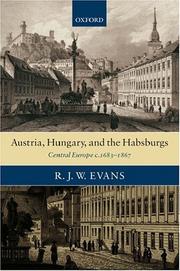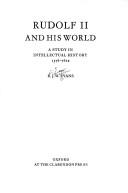| Listing 1 - 10 of 15 | << page >> |
Sort by
|

ISBN: 9780199281442 0199281440 Year: 2006 Publisher: Oxford ; Oxford university press
Abstract | Keywords | Export | Availability | Bookmark
 Loading...
Loading...Choose an application
- Reference Manager
- EndNote
- RefWorks (Direct export to RefWorks)
These elegantly written essays by the leading historian of the Austro-Hungarian empire explore the political and religious history of the Habsburg lands, Europe's only true multinational state. They illuminate key aspects of the evolution towards modern statehood and national awareness in Central Europe over more than two centuries of cultural and social transition. - ;This book address a number of interrelated themes over two hundred years and more in the political, religious, cultural, and social history of a broad but often neglected swathe of the European continent. It seeks - against the
Habsburg, House of. --- Europe, Central --- Austria --- Hungary --- History. --- Historiography. --- History of Eastern Europe --- Habsburg [Dynasty] --- anno 1600-1699 --- anno 1700-1799 --- anno 1800-1899 --- al-Nimsā --- Alpen- und Donau-Reichsgaue --- Ao-ti-li --- Austrian Republic --- Ausztria --- Autriche (Republic) --- Avstrii︠a︡ --- Avstrija --- Avusturya --- Deutschösterreich --- German Austria --- Österreich --- Ostmark --- Østrig --- Osṭriyah --- Ōsutoria --- Rakousko --- Republic of Austria --- Republik Österreich --- אוסטריה --- オーストリア --- Austro-Hungarian Monarchy --- Holy Roman Empire --- Habsbourg (famille de) --- Europe centrale --- Autriche --- Hongrie --- Histoire --- 1699-1848 --- 1849-1867
Book
ISBN: 3205063899 9783205063896 Year: 1989 Publisher: Wien: Böhlau,
Abstract | Keywords | Export | Availability | Bookmark
 Loading...
Loading...Choose an application
- Reference Manager
- EndNote
- RefWorks (Direct export to RefWorks)

ISBN: 019821961X Year: 1984 Publisher: Oxford : Clarendon press,
Abstract | Keywords | Export | Availability | Bookmark
 Loading...
Loading...Choose an application
- Reference Manager
- EndNote
- RefWorks (Direct export to RefWorks)
Book
Year: 1973 Publisher: Oxford : Clarendon Press,
Abstract | Keywords | Export | Availability | Bookmark
 Loading...
Loading...Choose an application
- Reference Manager
- EndNote
- RefWorks (Direct export to RefWorks)
Rudolf --- Bohemia (Czech Republic) --- Bohemia (Czech Republic) --- Holy Roman Empire --- Intellectual life --- Intellectual life --- Intellectual life.
Book
Year: 1973 Publisher: Oxford Clarendon Press
Abstract | Keywords | Export | Availability | Bookmark
 Loading...
Loading...Choose an application
- Reference Manager
- EndNote
- RefWorks (Direct export to RefWorks)
Book
Year: 1979 Publisher: Oxford Clarendon Press
Abstract | Keywords | Export | Availability | Bookmark
 Loading...
Loading...Choose an application
- Reference Manager
- EndNote
- RefWorks (Direct export to RefWorks)
Periodical
Year: 1995 Publisher: Oxford Clarendon Press
Abstract | Keywords | Export | Availability | Bookmark
 Loading...
Loading...Choose an application
- Reference Manager
- EndNote
- RefWorks (Direct export to RefWorks)
Multi
ISSN: 22127410 ISBN: 9789004206830 9004206833 9004228721 Year: 2012 Volume: 1 Publisher: Leiden Brill
Abstract | Keywords | Export | Availability | Bookmark
 Loading...
Loading...Choose an application
- Reference Manager
- EndNote
- RefWorks (Direct export to RefWorks)
In the early modern period the Holy Roman Empire, or Reich, was one of the oldest and largest European states. Its importance was magnified by its location at the heart of the continent, by the extensive international connections of its leading families, and by the involvement of foreign rulers in its governance. This book breaks new ground in its collective exploration of aspects of cross-border and transnational interaction, and of political and diplomatic, social and cultural relations. There are essays on important turning-points, especially 1648 and 1806; on the patterns of rulership of the emperors themselves; on areas which lay on the margin of the Reich; on neighbouring countries which interacted with the Empire; and on visual and material culture. Contributors are Wolfgang Burgdorf, Olivier Chaline, Heinz Duchhardt, Jeroen Duindam, Robert Evans, Sven Externbrink, Robert Frost, Lothar Höbelt, Thomas DaCosta Kaufmann, Petr Mat'a, Nicolette Mout, Thomas Munck, Géza Pálffy, Jaroslav Pánek, Adam Perłakowski, Friedrich Polleroß, Blythe Alice Raviola. Peter Schröder, Kim Siebenhüner, Peter H. Wilson and Thomas Winkelbauer.
Holy Roman Empire --- Saint Empire romain germanique --- History. --- Politics and government --- Histoire --- Politique et gouvernement --- --Temps modernes, --- History --- Politics and government. --- Constitutional history --- Temps modernes, 1492-1789 --- Holy Roman Empire - History - 1517-1648 --- Holy Roman Empire - History - 1648-1804 --- Holy Roman Empire - History - 1273-1517 --- Holy Roman Empire - Politics and government
Book
ISBN: 9780230576025 0230576028 9780230283107 0230283101 1349366021 9786612997211 1282997211 Year: 2010 Volume: 8 Publisher: New York (N.Y.) : Palgrave Macmillan,
Abstract | Keywords | Export | Availability | Bookmark
 Loading...
Loading...Choose an application
- Reference Manager
- EndNote
- RefWorks (Direct export to RefWorks)
Civilization, Medieval --- Middle Ages --- National characteristics, European. --- Historiography. --- Europe --- History --- --Nation --- National characteristics, European --- European national characteristics --- Medievalists --- Medieval civilization --- Civilization --- Chivalry --- Renaissance --- Historiography --- Council of Europe countries --- Eastern Hemisphere --- Eurasia --- Moyen Age --- Civilisation médiévale --- Caractéristiques nationales européennes --- Historiographie --- Histoire --- Moyen âge, --- Civilisation --- --Historiographie --- --Nationalisme --- --Historiography --- Middle Ages - Historiography --- Civilization, Medieval - Historiography --- Moyen âge, 476-1492 --- Nationalisme --- Nation
Book
ISBN: 0450021882 9780450021886 Year: 1974 Publisher: London: New English Library,
Abstract | Keywords | Export | Availability | Bookmark
 Loading...
Loading...Choose an application
- Reference Manager
- EndNote
- RefWorks (Direct export to RefWorks)
| Listing 1 - 10 of 15 | << page >> |
Sort by
|

 Search
Search Feedback
Feedback About UniCat
About UniCat  Help
Help News
News